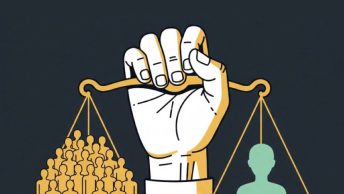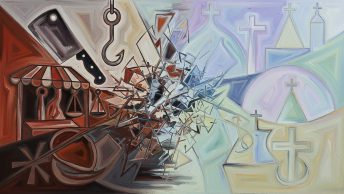It has been more than a year since Jammu and Kashmir (J&K) witnessed a vacuum of news and information with the sudden suspension of all means of communication after its special status was revoked. Major press freedom concerns persist in J&K despite the Supreme Court’s direction to review the restrictive orders on the internet in the Anuradha Bhasin judgement. To exacerbate the situation, the government took steps back from accountability and freedom by introducing the Media Policy, 2020 (“the Policy”).
The Policy aims to cover print media as well as online news portals, cable and satellite TV channels, FM and radio. It establishes a system of empanelment, which includes a background check of the newspaper owners, publishers and journalists. It empowers the Department of Information and Public Relations (“DIPR”) and security agencies to examine the media content before publication. Under the facade of creating a ‘sustained narrative and promoting the highest standards of journalism’, this policy is an expansive attempt to curb press freedom in J&K. This article attempts to analyse the policy in the backdrop of the Orwellian situation of the valley, while drawing parallels between the policy and repressive measures of censorship witnessed by the country in the past.
India’s Antecedents of Press Censorship
Censorship of press in independent India can be traced back to the national emergency in 1975. It began with the issuance of the Central Censorship Order and Guidelines, which mandated that news, and comments on the actions taken by the government should be submitted for scrutiny to an authorized government official before publication. The final blow on journalists during the emergency was the enactment of the Prevention of Publication of Objectionable Matter Act, 1976, which empowered the government to effectively ban all publication which as per its discretion fell under restrictions of Article 19(2). The Media Policy is featured on similar lines where the control to approve lies with DIPR and security agencies, and has given a vast interpretative leeway to the authorities to decide the information fit for public dissemination.
Scrutiny of the Policy
The Policy empowers the DIPR and security agencies to examine the content for fake news, plagiarism, unethical and anti-national narratives. J&K is not oblivious to the role of security agencies in suppressing free press. At least 21 journalists have been killed since 1990 in targeted killings and now, the Policy hands these agencies a direct power to control the press. Given the history, it is safe to assume that such a measure will not be in favour of free press.
Under the Policy, any group or individual found guilty of disseminating fake, unethical, or plagiarized content would face penalties, including but not limited to de-empanelment and shall be booked under Indian Penal Code and Cyber laws. The appeal provision mandates the constitution of a review committee, but the inclusion of the Director DIPR in it casts aspersions. This provision essentially makes DIPR the governing authority as well as the adjudicating authority. On the contrary, the Print Media Advertising Policy, 2020 meant for newspapers and periodicals provides a procedure for de-empanelment, where a reasonable opportunity has to be provided to the concerned publisher.
The Policy also mandates that any media that is found to incite or intend to incite or question or violate the sovereignty of India shall not be advertised by the government. Government advertisements serve as an important source of revenue and denial of advertisements is one way to turn the press malleable and control the flow of information. This is similar to what the government did during the emergency when it categorised newspapers as ‘friendly’, ‘hostile’ and ‘neutral’, and pro-government newspapers were given advertisements, whereas newspapers critical of the government were denied advertisements. In Kashmir, local newspapers are dependent upon the government advertisements for revenues due to the absence of the private sector and even more so because of the pandemic. Even, Anuradha Bhasin’s Kashmir Times was denied advertisement in 2010 by the UPA on the grounds of its alleged ‘anti-national agenda’, making the newspaper lose 30 per cent of its funding. Similarly, in 2016, Kashmir Reader was banned and blocked from receiving any ads through the state government because it was allegedly a threat to ‘public tranquillity’.
The ambiguous nature of the policy provides the government a freehand to interpret provisions and media content. On pages 8 and 9, it lays down the mechanism to address issues of ‘fake news’, ‘plagiarism’, and ‘communally sensitive material’, but fails to define these terms, thus empowering the government to arbitrarily censor any journalism. In the absence of any definitions, a report critical of the government can easily be termed as ‘fake’ or ‘anti-national’. The government is already brazenly penalising people who attempt to reflect the ground realities of J&K, and this witch-hunt is likely to strengthen under the Policy. This is evident by the recent arrests of photojournalist Masrat Zahra under for uploading ‘anti-national’ posts, and journalist Peerzada Ashiq for publishing a ‘fake news’ item. These punitive measures are likely to result in a chilling effect wherein the journalists choose to stay silent rather than let the government adjudge their freedom of speech as a crime.
Test of Reasonableness
The Presidential Orders, 1954 permitted the J&K Legislature to construe the meaning of ‘reasonable restrictions’ as it deemed fit. However, post the revocation of Article 370, any restriction on freedom of speech has to pass the test of reasonableness under Article 19(2). To stand the test of reasonableness, the restrictions placed must have a proximate relation to a legitimate objective of the legislation and must be proportional in nature to ensure that the limitations placed are least violative of rights.
One of the objectives of the Policy is “to thwart mis-information, fake news and be alert to any attempts to use media ……to propagate any information prejudicial to the sovereignty and integrity of India”, which would qualify as a restriction under sovereignty and integrity of India. However, the nature of restrictions in The Policy are neither proximate nor proportional. Even though the Policy cites ‘significant law and order and security considerations’ of J&K to control the press, the State will have to provide evidence of imminent risk arising from the speech and not far-fetched speculations about future harms. Further, the policy does not stand the test of necessity since there are sufficient penal laws, such as Sections 124A and 153A, to control publications which threatened the security of state. Moreover, the restrictions are indirect in nature. For the government to restrict fake news, it will first have to prove that the ‘fake news’ caused consequences which threatened the aforementioned Article 19(2) ground. Thus, the Policy is intrusive in nature and aims at categorically restricting freedom of speech in J&K in absence of a proximate connection.
The Media Policy also raises two constitutional problems, which are closely connected to reasonableness: overbreadth and vagueness. A statute is overbroad when it allows the government to restrict protected as well as non-protected speech. Vagueness in a legislation precludes people from having a reasonable opportunity to know what the law prohibits and rather leaves them ‘in a boundless sea of uncertainty.’ This Policy’s overbroad provisions gives the government enough leeway to include any content as “unethical or anti-national” and curb the legitimate right to criticize and dissent. It creates a risk of liability on the journalists where even a minor error could lead to de-empanelment and punitive repercussions. The vagueness of the Policy leaves regulating agencies with a wide scope of implementing power and the lack of an attempt to even define the restrictions makes it impossible for one to know what kind of content falls within these restrictions and what does not. Thus, the Policy fails to fall under any reasonable restrictions to freedom of speech since the limitations that it places are not proportional to its objective of controlling information that threatens India’s sovereignty.
Conclusion
Gags on the media are an obvious feature of an autocratic regime and this Policy speaks volume about the state of democracy in Jammu and Kashmir. The Media Policy has uncanny similarities to the repressive laws during the emergency, which validate the fact that the media still remains vulnerable to governmental pressures. The measures of using government advertisements as a bargaining chip and acting as a media watchdog are intrusive and excessive, and confer on the government a blanket power to decide the future of disseminated information and control the narrative. The government’s attempt at fabricating a new normal in J&K is a wake-up call to make an effort in the direction of freedom of press and ensure that independent media remains an instrument of democracy, rather than an instrument to spew propaganda.







